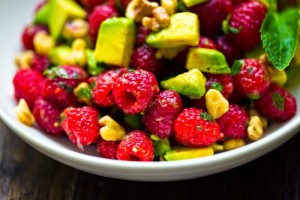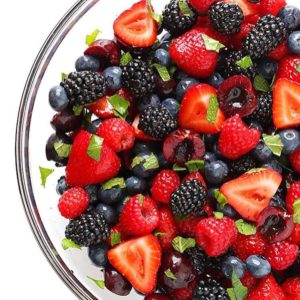Can the foods you eat beat inflammation? YES!
By Cathy Wong, ND | Reviewed by Richard N. Fogoros, MD
Updated February 23, 2018
The anti-inflammatory diet is an eating plan designed to prevent or reduce low-grade chronic inflammation, a key risk factor in a host of health problems and several major diseases. The typical anti-inflammatory diet emphasizes fruits, vegetables, lean protein, nuts, seeds, and healthy fats.
Often resulting from lifestyle factors like stress and a lack of exercise, chronic inflammation results when the immune system releases chemicals meant to combat injury and bacterial and virus infections, even when there are no foreign invaders to fight off.
Since our food choices influence the level of inflammation in our bodies, the anti-inflammatory diet is thought to curb chronic inflammation and help prevent or treat the following conditions: allergies, Alzheimer’s disease, arthritis, asthma, cancer, depression, diabetes, gout, heart disease, inflammatory bowel disease (such as ulcerative colitis and Crohn’s disease), irritable bowel syndrome (IBS), and stroke.
 Foods to Eat on the Anti-Inflammatory Diet
Foods to Eat on the Anti-Inflammatory Diet
Research suggests that people with a high intake of vegetables, fruits, nuts, seeds, healthy oils, and fish may have a reduced risk for inflammation-related diseases. In addition, substances found in some foods (especially antioxidants and omega-3 fatty acids) appear to possess anti-inflammatory effects.
Foods high in antioxidants include:
- Berries (such as blueberries, raspberries, and blackberries)
- Cherries
- Apples
- Artichokes
- Avocados
- Dark green leafy vegetables (such as kale, spinach, and collard greens)
- Sweet potatoes
- Broccoli
- Nuts (such as walnuts, almonds, pecans, and hazelnuts)
- Beans (such as red beans, pinto beans, and black beans)
- Whole grains (such as oats and brown rice)
- Dark chocolate (at least 70 percent cocoa)
Foods high in omega-3 fatty acids include:
- Oily fish (such as salmon, herring, mackerel, sardines, and anchovies)
- Flaxseed
- Walnuts
- Omega-3-fortified foods (including eggs and milk)
There’s also some evidence that certain culinary herbs and spices, such as ginger, turmeric, and garlic, can help alleviate inflammation.
 Foods to Avoid
Foods to Avoid
Omega-6 fatty acids (a type of essential fatty acid found in a wide range of foods) are known to increase the body’s production of inflammatory chemicals. Since omega-6 fatty acids help maintain bone health, regulate metabolism and promote brain function, you shouldn’t cut them out of your diet altogether. However, it’s important to balance your intake of omega-6 fatty acids with your intake of omega-3 fatty acids in order to keep inflammation in check.
Foods high in omega-6 fatty acids include:
- Meat
- Dairy products (such as milk, cheese, butter, and ice cream)
- Margarine
- Vegetable oils (such as corn, safflower, soybean, peanut and cottonseed oil)
Instead of vegetable oils, opt for oils like olive oil and avocado oil.
Additionally, studies show that a high intake of high-glycemic index foods like sugar and refined grains, such as those found in white bread and many processed foods, may rev up inflammation. Avoid sugary drinks, refined carbohydrates, desserts, and processed snack foods.
The Benefits of an Anti-Inflammatory Diet
More and more research suggests that an anti-inflammatory diet may play a key role in scores of health conditions. A study published in the British Journal of Nutrition in 2017, for instance, assessed the association between dietary inflammation (measured by a dietary inflammatory index) and atherosclerosis (the buildup of plaque in the arteries) in women over the age of 70. Researchers found that dietary inflammatory index scores were associated with subclinical atherosclerosis and heart-disease-related death.
Adhering to an anti-inflammatory diet may help reduce levels of certain inflammatory markers (such as a substance called C-reactive protein) in people with type 2 diabetes, according to a study published in Endocrine in 2016.
For the study, people with newly diagnosed type 2 diabetes followed the Mediterranean diet or a low-fat diet. After one year, C-reactive protein levels fell by 37 percent in people on the Mediterranean diet, but remained unchanged in those on the low-fat diet.
Meal Ideas
Breakfast foods: breakfast smoothie, chia bowl, oatmeal.
Lunch: salad with quinoa and vegetables, soup, grilled salmon.
Snacks: fresh blueberry fruit salad, apples and nut butter, walnuts, chia seed pudding, guacamole.
Beverages: ginger turmeric tea, golden milk, green juice, green smoothie, herbal tea, turmeric tea, green tea.
Tips on Following an Anti-Inflammatory Diet
- Eat five to nine servings of antioxidant-rich fruits and vegetables each day.
- Limit your intake of foods high in omega-6 fatty acids while increasing your consumption of foods rich in omega-3 fatty acids (such as flaxseed, walnuts, and oily fish like salmon, tuna, mackerel and herring).
- Replace red meat with healthier protein sources, such as lean poultry, fish, soy, beans and lentils.
- Swap out margarine and vegetable oils for the healthier fats found in olive oil, nuts, and seeds.
- Instead of choosing refined grains, opt for fiber-rich whole grains like oats, quinoa, brown rice, breads, and pastas that list a whole grain as the first ingredient.
- Rather than seasoning your meals with salt, enhance flavor with anti-inflammatory herbs like garlic, ginger, and turmeric.
A Word From Verywell
Choosing a variety of these delicious, antioxidant-rich foods can help curb inflammation in combination with exercise and a good night’s sleep, which may improve inflammation markers and possibly reduce your risk of many illnesses.
Sources:
Bondonno NP, Lewis JR, Blekkenhorst LC, et al. Dietary inflammatory index in relation to sub-clinical atherosclerosis and atherosclerotic vascular disease mortality in older women. Br J Nutr. 2017 Jun;117(11):1577-1586.
Maiorino MI, Bellastella G, Petrizzo M, Scappaticcio L, Giugliano D, Esposito K. Mediterranean diet cools down the inflammatory milieu in type 2 diabetes: the MÉDITA randomized controlled trial. Endocrine. 2016 Dec;54(3):634-641.





 Foods to Avoid
Foods to Avoid
